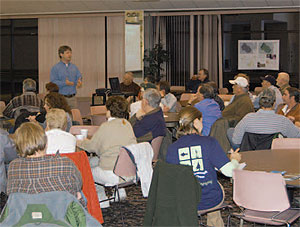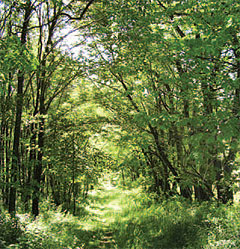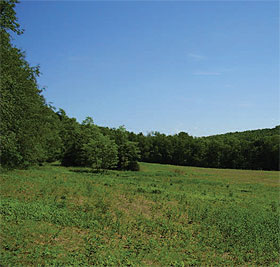The Land-Water Connection
Throughout The Western Pennsylvania Conservancy’s history, water conservation and land conservation have often gone hand-in-hand, and strong relationships with landowners are crucial to successful outcomes in both areas.
More recently, staff members from the Conservancy’s longstanding Land Conservation and Stewardship Program and the newer Watershed Conservation Program are finding great success in working together to bring the maximum benefit to conservation-minded landowners.
Land Conservation that Benefits Watersheds
One highly effective method of protecting waterways is to conserve the land that surrounds it. With that in mind, WPC began improving watersheds in Western Pennsylvania almost from its start.

Mike Kuzemchak, Laurel Highlands project director, meets with Tubmill Creek residents about WPC’s efforts in their area.
The Conservancy’s significant land conservation initiatives along waterways such as the Clarion, Allegheny and Youghiogheny rivers, as well as French Creek, have played a key role in the region’s waters becoming or remaining healthy.
WPC has conserved 12,276 acres along the Clarion River, from Ridgway to Clarion, and more than 20,000 acres along the Youghiogheny River and its tributaries, including Ohiopyle State Park and Fallingwater’s Bear Run. To date, WPC acreage protected along French Creek totals nearly 3,500.
Since 1971, WPC also has conserved nearly 22,000 acres of land and subsurface rights that are now part of the Allegheny National Forest (ANF). The ANF was established in the early twentieth century with a primary focus on protecting important watershed land at the headwaters of the Allegheny River, and thus improving the quality and navigability of the downriver waterways. Extensive logging in that area had made the land vulnerable to fires and erosion.
In total, the Conservancy has protected 82,767 acres in the Allegheny River watershed, including the islands that make up the Allegheny Islands Wilderness area.
Land and Water Conservation Staff Team Up for Landowners

Wib and Carol Newell’s conservation efforts will protect the headwaters of Loyalhanna Creek.
Since the establishment of WPC’s Watershed Conservation Program in 2001, the land-water connection has become even stronger. As staff members from the respective programs assist landowners in meeting their conservation objectives, it is not uncommon to also connect them with the other arm of the organization for additional assistance.
A recent example of such a landowner relationship involves the Newell farm in Donegal Township, Westmoreland County.
Wib and Carol Newell, whose family has owned their 172-acre property just below the headwaters of the Loyalhanna Creek since 1972, wanted to find a way to keep it in the family and continue their lifelong dream of owning a farm.
The Newells’ first contact with WPC was with Ben Wright, assistant director of the Watershed Conservation Program. Wright worked with them to secure government funds to plant a two-acre buffer zone along the creek, and stabilize a stream crossing for their cattle and machinery. WPC also worked with the Newells to enroll their farm in the Conservation Reserve Enhancement Program (CREP). Through CREP, Watershed staff members were able to help establish 67 acres of warm-season grasses to stabilize highly erodible soils on the farm.

The Newell property.
After those improvements were complete, Wright connected the Newells with Mike Kuzemchak, WPC’s Laurel Highlands program director for land conservation. Kuzemchak helped secure private and state funds to establish an agricultural easement, which is a permanent deed restriction that limits the property’s development in perpetuity and its future use to sustainable agricultural purposes including crops, livestock or timber. The easement is held by the Westmoreland County Agricultural Lands Preservation Board.
The additional dollars that resulted from taking these steps have allowed the Newells to better protect the creek and to keep the farm in their family.
“This was an important property for protection because of its location at the headwaters of the Loyalhanna Creek and its proximity to over 3,000 acres of other property that WPC has conserved through conservation easements,” Kuzemchak said.
